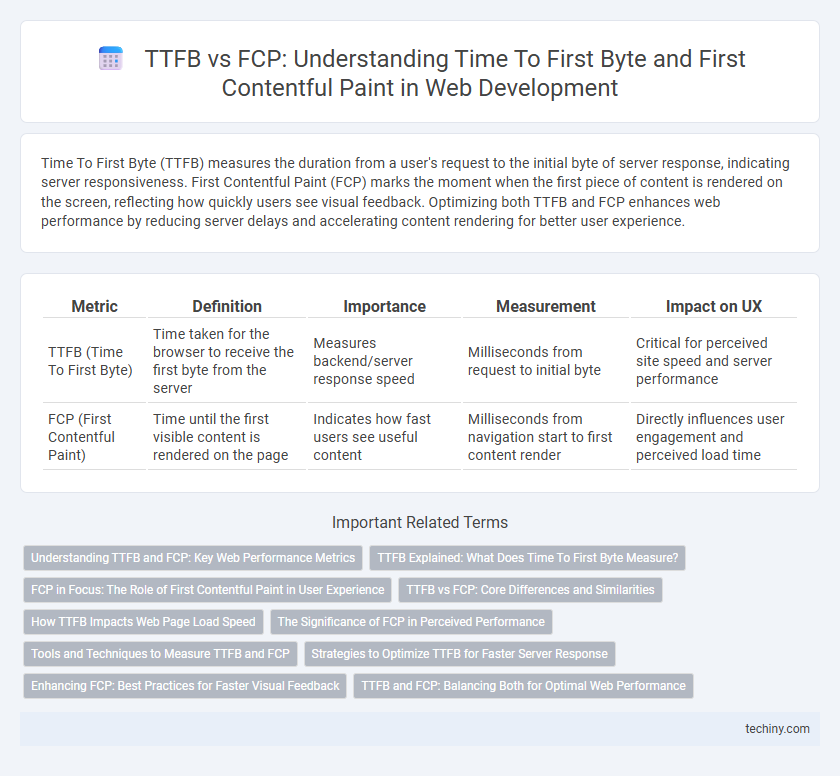Time To First Byte (TTFB) measures the duration from a user's request to the initial byte of server response, indicating server responsiveness. First Contentful Paint (FCP) marks the moment when the first piece of content is rendered on the screen, reflecting how quickly users see visual feedback. Optimizing both TTFB and FCP enhances web performance by reducing server delays and accelerating content rendering for better user experience.
Table of Comparison
| Metric | Definition | Importance | Measurement | Impact on UX |
|---|---|---|---|---|
| TTFB (Time To First Byte) | Time taken for the browser to receive the first byte from the server | Measures backend/server response speed | Milliseconds from request to initial byte | Critical for perceived site speed and server performance |
| FCP (First Contentful Paint) | Time until the first visible content is rendered on the page | Indicates how fast users see useful content | Milliseconds from navigation start to first content render | Directly influences user engagement and perceived load time |
Understanding TTFB and FCP: Key Web Performance Metrics
Time To First Byte (TTFB) measures the duration from a user's request to the first byte of the server's response, reflecting server responsiveness and network latency. First Contentful Paint (FCP) records the time it takes for the browser to render the first piece of content, indicating when users perceive the page as loading. Optimizing TTFB improves backend performance, while enhancing FCP focuses on frontend rendering speed, both crucial for superior web performance and user experience.
TTFB Explained: What Does Time To First Byte Measure?
Time To First Byte (TTFB) measures the duration from a user's request to the moment the first byte of a response is received by the browser, reflecting the server's responsiveness. It includes DNS lookup, TCP connection, and server processing time, making it a crucial metric for assessing backend performance in web development. Optimizing TTFB helps reduce latency, enhancing overall page load speed and user experience.
FCP in Focus: The Role of First Contentful Paint in User Experience
First Contentful Paint (FCP) measures the time it takes for a web page to render the first piece of content, such as text or images, providing users with immediate visual feedback and improving perceived load speed. Unlike Time To First Byte (TTFB), which tracks server responsiveness, FCP focuses on actual content delivery and rendering on the client side, making it a critical metric for assessing user experience in web development. Optimizing FCP enhances user engagement by reducing perceived waiting times and increasing the likelihood of retaining visitors during page load.
TTFB vs FCP: Core Differences and Similarities
TTFB (Time To First Byte) measures the duration between a user's request and the initial byte of the server's response, reflecting server responsiveness. FCP (First Contentful Paint) tracks the time until the first visible content element is rendered on the screen, indicating the start of user-perceivable loading. Both metrics assess loading performance but differ as TTFB focuses on backend server speed and network latency, while FCP captures frontend rendering progress and user experience.
How TTFB Impacts Web Page Load Speed
Time To First Byte (TTFB) measures the delay between a user's request and the first byte of a response arriving from the server, directly influencing overall web page load speed. A lower TTFB improves server responsiveness, enabling faster First Contentful Paint (FCP), which is critical for user-perceived performance. Optimizing server configurations, using Content Delivery Networks (CDNs), and minimizing backend processing time effectively reduce TTFB and enhance initial content rendering.
The Significance of FCP in Perceived Performance
First Contentful Paint (FCP) measures the time it takes for the browser to render the first piece of content, significantly influencing the user's perception of web performance. Unlike Time To First Byte (TTFB), which gauges server responsiveness, FCP directly impacts user engagement by signaling when meaningful content appears. Optimizing FCP improves perceived load speed, reducing bounce rates and enhancing overall user experience.
Tools and Techniques to Measure TTFB and FCP
Accurate measurement of TTFB (Time To First Byte) and FCP (First Contentful Paint) can be achieved using tools like Google Chrome DevTools, WebPageTest, and Lighthouse, which provide detailed timing breakdowns crucial for performance analysis. Techniques such as utilizing the Performance Timing API and Navigation Timing API enable developers to programmatically capture these metrics on real user sessions for precise monitoring. Leveraging these tools helps optimize server response time for TTFB and improve rendering speed impacting FCP in web development.
Strategies to Optimize TTFB for Faster Server Response
Reducing Time To First Byte (TTFB) significantly improves server response speed by optimizing backend performance and minimizing latency through strategies like efficient database queries, server-side caching, and use of Content Delivery Networks (CDNs). Implementing HTTP/2 or HTTP/3 protocols enhances connection reuse and reduces handshake times, directly lowering TTFB. These server-level optimizations contribute to faster First Contentful Paint (FCP) by delivering initial HTML content more quickly to the browser.
Enhancing FCP: Best Practices for Faster Visual Feedback
Improving First Contentful Paint (FCP) is crucial for delivering faster visual feedback and enhancing user experience in web development. Techniques such as optimizing server response times to reduce Time To First Byte (TTFB), implementing critical CSS inline, and deferring non-essential JavaScript help accelerate content rendering. Prioritizing resource loading, leveraging browser caching, and using content delivery networks (CDNs) further minimize delays and improve overall page load performance.
TTFB and FCP: Balancing Both for Optimal Web Performance
TTFB (Time To First Byte) measures the duration between a user's request and the first byte received from the server, reflecting server responsiveness and network latency. FCP (First Contentful Paint) tracks the time when the browser renders the first piece of content, indicating how quickly users see visual feedback from a page. Balancing TTFB and FCP optimization ensures faster server responses alongside prompt content rendering, leading to superior web performance and improved user experience.
TTFB vs FCP (Time To First Byte vs First Contentful Paint) Infographic

 techiny.com
techiny.com